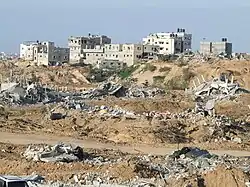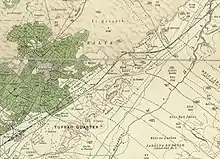Jabalia | |
|---|---|
| Arabic transcription(s) | |
| • Arabic | جباليا |
| • Latin | Jabalya (official) |
 Jabalia after the 2009 Gaza war | |
 Jabalia Location of Jabalia within Palestine | |
| Coordinates: 31°31′41″N 34°28′59″E / 31.52806°N 34.48306°E | |
| Palestine grid | 100/103 |
| State | |
| Governorate | North Gaza |
| Government | |
| • Type | City |
| Population (2017)[1] | |
| • Total | 172,704 |
| Name meaning | "The mountaineers"[2] |
| Website | www |
Jabalia, also spelled Jabalya (Arabic: جباليا), is a Palestinian city located 4 kilometers (2.5 mi) north of Gaza City, in the North Gaza Governorate of the State of Palestine, in the Gaza Strip. According to the Palestinian Central Bureau of Statistics, Jabalia had a population of 172,704 in 2017.[1] The Jabalia refugee camp is adjacent to the city to the north. The nearby town of Nazla is a part of the Jabalia municipality. The city is currently under the operational control of IDF's 162nd Division.[3]
Archaeology
A large cemetery dating to the 8th century CE was found near Jabalia. The workmanship indicates that the Christian community in Gaza was still very much in existence in the early Islamic era of rule in Palestine, and capable of artistic achievements. The remains of the pavement spared by the iconoclasts show depictions of wild game, birds, and country scenes. The late dating of the mosaic pavement proves that the intervention of the iconoclasts, after 750, is later than previously thought and is associated with Abbasid conservatives.[4]
While working on the Salah al-Din Road, laborers accidentally uncovered a monastery from the Byzantine period. The site was excavated by the Palestinian Department of Antiquities. Now the stunning Byzantine mosaics of the monastery are covered with sand to shield them from erosion caused by the direct impact of the winter rain.[5] Byzantine ceramics have also been found.[6]
In 2022, the restoration of a fifth-century Byzantine church carried out by the French organisation Premiere Urgence Internationale and the British Council was finished. The church is decorated with mosaics and religious texts written in Greek.[7]
History
Jabalia was known for its fertile soil and citrus trees. The Mamluk Governor of Gaza Sanjar al-Jawli ruled the area in the early 14th century and endowed part of Jabalia's land to the al-Shamah Mosque he built in Gaza.
Until 2014, Jabalia also had the ancient Omari Mosque. The site was believed to have housed a mosque since the seventh century, and its portico and minaret dated back to the 14th century, but the Omari was destroyed by Israeli bombings in 2014.[8] The portico consists of three arcades supported by four stone columns. The arcades have pointed arches and the portico is covered by crossing vaults.[9]
Ottoman period
Incorporated into the Ottoman Empire in 1517 with all of Palestine, Jabalia appeared in 1596 tax registers as being in the Nahiya of Gaza of the Liwa of Gazza. It had a population of 331 households, all Muslim, who paid taxes on wheat, barley, vine yards, and fruit trees; a total of 37,640 akçe. 2/3 of the revenue went to a waqf.[10]
In 1838, Edward Robinson noted Jebalia as a Muslim village, located in the Gaza district.[11]
In 1863, the French explorer Victor Guérin found in the mosque fragments of old constructions, and at the well some broken columns.[12] An Ottoman village list from about 1870 found that the village had a population of 828, in a total of 254 houses, though the population count included men, only.[13][14]
In the Palestine Exploration Fund's 1883 Survey of Western Palestine, Jabalia was described as being a large adobe village, with gardens and a well on the northwest. It had a mosque named Jamia Abu Berjas.[15]
British Mandate era
In the 1922 census of Palestine conducted by the British Mandate authorities, Jabalia had a population of 1,775 inhabitants, all Muslim,[16] increasing in the 1931 census to 2,425, still all Muslims, in 631 houses.[17]


In the 1945 statistics, Jabalia had a population of 3,520, all Muslims,[18] with 11,497 dunams of land, according to an official land and population survey.[19] Of this, 138 dunams were for citrus and bananas, 1,009 for plantations and irrigable land, 1,036 for cereals,[20] while 101 dunams were built-up land.[21]
Post-1948
During the early months of First Intifada on 27 March 1989 Fares S'aid Falcha, aged 50, was beaten by Israeli soldiers. He died 3 weeks later in the Makassed Hospital. A report was compiled by the Military Police Investigators and details were passed on to the Chief Military Prosecutor.[22]
In late 2006, Jabalia was the scene of mass protests against airstrikes on militants' homes. Israel contacted the residences of several Hamas members who launched missiles at Israeli civilians from the houses, warning them of an airstrike within the next 30 minutes. Neighbors responded by forming a human shield and successfully stalled the demolition.[23] In 2021, seven people were killed by a Hamas rocket.
2023 Israeli air-strikes
The Jabalia refugee camp, which has been the target of multiple Israeli air strikes during the 2023 Israel-Hamas war, was struck again on 31 October.[24] The Israeli air-strike killed at least 50 Palestinians and trapped more than a hundred beneath the rubble, according to the Gaza Health Ministry.[25] The Indonesia Hospital said most casualties were women and children.[26] Gaza Interior Ministry stated the camp had been "completely destroyed," with preliminary estimates of about 400 wounded or dead.[27] IDF spokesperson Daniel Hagari confirmed that Israeli fighter jets attacked the refugee camp,[28] and stated that the attack killed a Hamas commander who led the 7 October attacks, dozens of Palestinian militants, and destroyed Palestinian tunnels.[29] Hamas claims none of its commanders were present and that Israel was using these claims as an excuse for the attack.[30]
Demographics
A number of male pseudohermaphrodite births have been reported in Jabalia. Jehad Abudaia, a Canadian-Palestinian pediatrician and urologist, has suggested that consanguinity due to cousin marriages accounts for the prevalence of pseudohermaphrodite births. In the Gaza Strip, pseudohermaphrodite conditions often go undetected for years after birth due to the region's lower standards of medical treatment and diagnostics.[31]
Twin towns – sister cities
 Ümraniye, Turkey
Ümraniye, Turkey
References
- 1 2 Preliminary Results of the Population, Housing and Establishments Census, 2017 (PDF). Palestinian Central Bureau of Statistics (PCBS) (Report). State of Palestine. February 2018. pp. 64–82. Retrieved 2023-10-24.
- ↑ Palmer, 1881, p. 360
- ↑ "Senior IDF officer: We've managed to 'break operational abilities' of Hamas' northern Gaza City brigade | The Times of Israel".
- ↑ Humbert, Jean-Baptiste. The rivers of Paradise in the Byzantine Church near Jabaliyah - Gaza Archived 2009-02-27 at the Wayback Machine Studium Biblicum Franciscanum - Jerusalem. 16 December 2000.
- ↑ Jabalya Mosaic Archived 2009-03-27 at the Wayback Machine Programme of Assistance to the Palestinian People. p.6. 2004.
- ↑ Dauphin, 1998, p. 883
- ↑ "Restored Byzantine church re-opens in Gaza". www.hurriyetdailynews.com. 26 January 2022. Retrieved 31 October 2023.
- ↑ AFP. "Long-neglected Gaza heritage wilts in war". www.timesofisrael.com. Retrieved 2022-12-16.
- ↑ Travel in Gaza Archived 2013-08-23 at the Wayback Machine MidEastTravelling.
- ↑ Hütteroth and Abdulfattah, 1977, p. 144
- ↑ Robinson and Smith, 1841, vol 3, Appendix 2, p. 118
- ↑ Guérin, 1869, pp. 175-176; as referred by Conder and Kitchener, 1883, SWP III, p. 251
- ↑ Socin, 1879, p. 153
- ↑ Hartmann, 1883, p. 129, noted 253 houses
- ↑ Conder and Kitchener, 1883, SWP III, p. 236
- ↑ Barron, 1923, Table V, Sub-district of Gaza, p. 8
- ↑ Mills, 1932, p. 4
- ↑ Department of Statistics, 1945, p. 31
- ↑ Government of Palestine, Department of Statistics. Village Statistics, April 1945. Quoted in Hadawi, 1970, p. 45
- ↑ Government of Palestine, Department of Statistics. Village Statistics, April 1945. Quoted in Hadawi, 1970, p. 87
- ↑ Government of Palestine, Department of Statistics. Village Statistics, April 1945. Quoted in Hadawi, 1970, p. 137
- ↑ Talmor, Ronny (translated by Ralph Mandel) (1990) The Use of Firearms - By the Security Forces in the Occupied Territories. B'Tselem. download p. 75 MK Yair Tsaban to defence ministers Yitzhak Rabin & Yitzhak Shamir, p.81 Rabin's reply
- ↑ Conal Urquhart in Tel Aviv (2006-11-20). "Palestinians use human shield to halt Israeli air strike on militants' homes | World news". The Guardian. London. Retrieved 2010-05-08.
- ↑ Mpoke Bigg, Matthew; Zraick, Karen; Boxerman, Aaron (31 October 2023). "Images of the Jabaliya refugee camp show a large crater and widespread damage". The New York Times. Retrieved 31 October 2023.
- ↑ "Rescue teams trying to evacuate people from under the rubble". Al Jazeera. Retrieved 31 October 2023.
- ↑ David Gritten. "Jabalia: Israel air strike reportedly kills dozens at Gaza refugee camp". BBC News.
- ↑ "Jabalia refugee camp 'completely destroyed'". Al Jazeera. Retrieved 31 October 2023.
- ↑ "Israel Gaza live news: Dozens reported killed in Gaza refugee camp blast". BBC News. 30 October 2023. Retrieved 31 October 2023.
- ↑ "Dozens reported killed in Gaza refugee camp blast". BBC News. 30 October 2023. Retrieved 1 November 2023.
- ↑ Al-Mughrabi, Nidal; Rose, Emily; Al-Mughrabi, Nidal (31 October 2023). "Israel strikes dense Gaza camp, says it kills Hamas commander". Reuters. Retrieved 1 November 2023.
- ↑ Watson, Ivan. "Rare Gender Identity Defect Hits Gaza Families." CNN. December 17, 2009. Retrieved on December 17, 2009.
- ↑ "Ümraniye Municipality and Palestine Jabalia Al Nazlah Municipality Has Become 'Sister Municipalities' With a Ceremony". umraniye.bel.tr. Ümraniye. Retrieved 2020-06-01.
Bibliography
- Barron, J.B., ed. (1923). Palestine: Report and General Abstracts of the Census of 1922. Government of Palestine.
- Conder, C.R.; Kitchener, H.H. (1883). The Survey of Western Palestine: Memoirs of the Topography, Orography, Hydrography, and Archaeology. Vol. 3. London: Committee of the Palestine Exploration Fund.
- Dauphin, C. (1998). La Palestine byzantine, Peuplement et Populations. BAR International Series 726 (in French). Vol. III : Catalogue. Oxford: Archeopress. ISBN 0-860549-05-4.
- Department of Statistics (1945). Village Statistics, April, 1945. Government of Palestine.
- Guérin, V. (1869). Description Géographique Historique et Archéologique de la Palestine (in French). Vol. 1: Judee, pt. 2. Paris: L'Imprimerie Nationale.
- Hadawi, S. (1970). Village Statistics of 1945: A Classification of Land and Area ownership in Palestine. Palestine Liberation Organization Research Center.
- Hartmann, M. (1883). "Die Ortschaftenliste des Liwa Jerusalem in dem türkischen Staatskalender für Syrien auf das Jahr 1288 der Flucht (1871)". Zeitschrift des Deutschen Palästina-Vereins. 6: 102–149.
- Hütteroth, Wolf-Dieter; Abdulfattah, Kamal (1977). Historical Geography of Palestine, Transjordan and Southern Syria in the Late 16th Century. Erlanger Geographische Arbeiten, Sonderband 5. Erlangen, Germany: Vorstand der Fränkischen Geographischen Gesellschaft. ISBN 3-920405-41-2.
- Mills, E., ed. (1932). Census of Palestine 1931. Population of Villages, Towns and Administrative Areas. Jerusalem: Government of Palestine.
- Palmer, E.H. (1881). The Survey of Western Palestine: Arabic and English Name Lists Collected During the Survey by Lieutenants Conder and Kitchener, R. E. Transliterated and Explained by E.H. Palmer. Committee of the Palestine Exploration Fund.
- Robinson, E.; Smith, E. (1841). Biblical Researches in Palestine, Mount Sinai and Arabia Petraea: A Journal of Travels in the year 1838. Vol. 3. Boston: Crocker & Brewster.
- Socin, A. (1879). "Alphabetisches Verzeichniss von Ortschaften des Paschalik Jerusalem". Zeitschrift des Deutschen Palästina-Vereins. 2: 135–163.
External links
- UNRWA Jabalia
- Welcome To The City of Jabaliya
- Survey of Western Palestine, Map 19: IAA, Wikimedia commons